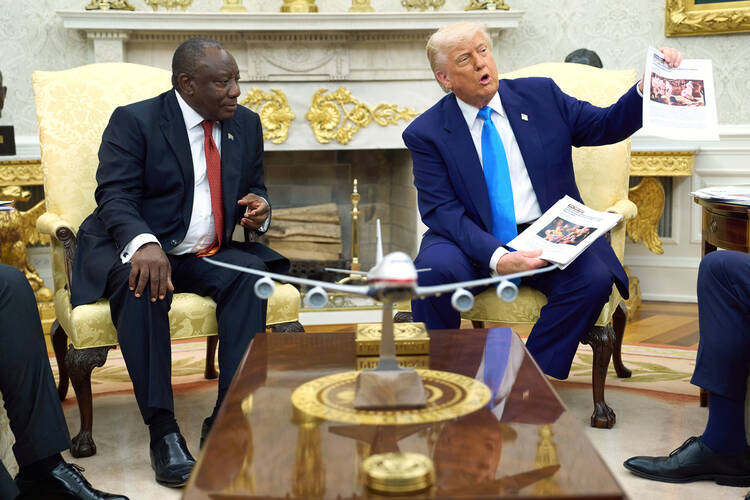Pope Leo XIV warns about the dangers of false information
Pope Leo XIV addressed the members of a Vatican group of religious and business leaders in Rome on May 17, expressing a concern that “there is so little dialogue around us; shouting often replaces it, not infrequently in the form of fake news and irrational arguments proposed by a few loud voices.”
The pope advised that “deeper reflection and study are essential.” He said that the signs of the times call for a pause, a moment to “rediscover, articulate, and cultivate the [church’s] mission of educating in critical thinking.”
A few days later, South African President Cyril Ramaphosa came to Washington on May 21 seeking to halt a serious slide in relations between the United States and his nation.
The spectacle the world was treated to suggests Mr. Ramaphosa was not successful. According to The New York Times, after a journalist asked what it would take for Mr. Trump to see that there is no “white genocide” in South Africa, the U.S. president subjected the press, and his distinguished guest, to a video presentation. Mr. Ramaphosa watched scenes of his political opposition, the Economic Freedom Fighters, throwing red meat to its supporters.
Mr. Trump provided commentary during the show, at one point noting a row of hundreds of white crosses along a South African roadside. “These are burial sites…over 1,000 of white farmers and…those cars aren’t driving, they’re stopped there to pay respects to their family member who was killed,” Mr. Trump told Mr. Ramaphosa.
That, of course, was not true. The farmers who erected those crosses told BBC News that they marked not burial sites but a memorial for Glen and Vida Rafferty, who had been killed on their farm in August 2020. Two local men, in fact, were convicted of robbery and homicide in the Rafferty killings in 2022. Tragic and unacceptable those killings were, but they don’t constitute evidence of a genocide directed by the South African government.
Other “evidence” of white genocide shared by the president was similarly based on erroneous, hyperbolized or completely fabricated reporting collected from dubious sources off the wondrous World Wide Web—including a printed-out blog post with a photo from the Democratic Republic of the Congo and not, as Mr. Trump implied, from South Africa.
Exiting the meeting, Mr. Trump, oblivious to the uproar that followed his treatment of a visiting dignitary, seems as convinced as ever of of white genocide in South Africa. A South African court has dismissed claims of a white genocide in the country as “clearly imagined” and “not real”, undermining comments made by President Trump and his South African-born adviser Elon Musk.
No one would deny that violent crime is a serious problem in contemporary South Africa, including Mr. Ramaphosa, who acknowledged the matter in a fruitless effort to convey some truth about his nation to Mr. Trump during their meeting. But according to the data, only a handful of victims were farmers. Only willful distortion can transform those numbers into a charge of genocide.
The president has the best intelligence gathering teams in the world at his disposal, career civil servants and members of the U.S. military who could easily provide evidence for his allegations of white genocide or blow holes in them. Based on his performance this week, he prefers instead to place his trust in dubious reporting harvested from the internet and the poisonous counsel of a high-placed advisor who has demonstrated alarming gullibility in his own consumption and promotion of internet disinformation.
— Kevin Clarke, America magazine / May 22 2025



